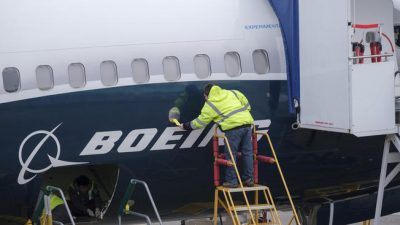“They Are Prone to Cracking”: FAA Orders Boeing to Replace Wing Components on Hundreds of 737s

As if trade war wasn’t enough for traders to worry about with futures reopening sharply lower after China’s government blamed the U.S. for the latest collapse in trade talks, it appears that Boeing is about to resume the position as yet another very popular 737 model suddenly finds itself in hot water.
Accord to Bloomberg, the wing components on as many as 312 Boeing 737s, including some of the grounded 737 Max, are prone to cracking and must be repaired within 10 days, aviation regulators said late Sunday.
With Boeing already under scrutiny for the 737 MAX fiasco, Boeing – which is suddenly finding a lot of faults that never existed before the company found itself under congressional scrutiny – informed the FAA that so-called “leading edge slat tracks” may not have been properly manufactured and pose a safety risk, the agency said. The parts allow the wing to expand to create more lift during takeoff and landing.
In response, the FAA plans to issue an order calling for operators of the planes worldwide to identify whether the deficient parts were installed and to replace them. A complete failure wouldn’t lead to a loss of the aircraft, the FAA – which was humiliated for siding with Boeing and was initially against the grounding of the 737 MAX only to flip flop when the rest of the world boycotted the troubled airliner – said, but “could cause damage during flight.”
Because “damage during flight” of a key component rarely if ever leads to a “loss of the aircraft”?
As Boeing noted in the statement, it has notified operators of the planes about the needed repairs and is sending replacement parts to help minimize the time aircraft are out of service, the company said in a statement.
Boeing identified 148 parts made by a subcontractor that are affected. The parts may be on a total of 179 737 Max aircraft and 133 737 NG planes worldwide, including 33 Max and 32 NG aircraft in the U.S., the FAA said. The NG, or Next Generation, 737s are a predecessor to the Max family (which by that logic must be the next, next generation).
So many 737MAX… pic.twitter.com/uG5OMusg8l
— Jeremy Dwyer-Lindgren (@photoJDL) June 2, 2019
This latest quality control fiasco piles on even more problems for Boeing, whose 737 Max has been grounded worldwide since March 13 after two fatal crashes tied to a malfunction that caused a flight control system to repeatedly drive down the plane’s nose. Boeing is finalizing a “software fix” along with proposed new training that will be required before the planes fly again. One only hopes that Boeing’s software “fix” isn’t in some way connected to the Google cloud…
*
Note to readers: please click the share buttons above or below. Forward this article to your email lists. Crosspost on your blog site, internet forums. etc.

